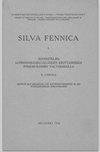Comparison of planting success in one-year-old spring, summer and autumn plantings of Norway spruce and Scots pine under boreal conditions
IF 1.7
3区 农林科学
Q2 FORESTRY
引用次数: 7
Abstract
In Nordic countries, tree planting of seedlings is mainly performed during spring and early summer. Interest has increased in extending the planting window throughout the unfrozen growing season. This study compared the success of one-year-old spring, summer and autumn plantings in practical forestry in Norway spruce (Picea abies (L.) Karst.) and Scots pine (Pinus sylvestris L.) in southern and central Finland. Planting success was based on the number of viable seedlings per hectare relative to a species-specific target density. The influence of different factors to poor planting results were determined, including quality of site preparation and planting, and sources of natural damage. Overall, in Norway spruce, 85, 69 and 84% and in Scots pine 53, 55 and 40% of spring, summer and autumn plantings succeeded. In Norway spruce, the planting results were consistent between the southern and central regions, whereas in Scots pine, the success was slightly lower in the south. The poor work quality and a low density of appropriate planting spots, contributed to poor planting results, regardless of planting season, region or tree species. Considering different damages, especially mammal damage contributed to the failure of Scots pine spring plantings, whereas in summer plantings, corresponding single failure reason could not be identified. Based on our findings, extending the planting season of Norway spruce could be recommended in both regions. For Scots pine, there is still significant uncertainty about the success of summer and autumn plantings, partially due to the limited number of plantings available for analyses.北方条件下一年生挪威云杉和苏格兰松春、夏、秋种植成功的比较
在北欧国家,树苗种植主要在春季和初夏进行。人们对延长整个不冻生长季节的种植窗口越来越感兴趣。本研究比较了挪威云杉(Picea abies (L.))一年生春季、夏季和秋季种植在实际林业中的成功情况。)和苏格兰松(Pinus sylvestris L.),分布在芬兰南部和中部。种植成功与否取决于相对于特定物种目标密度的每公顷活苗数量。确定了不同因素对不良种植效果的影响,包括立地准备和种植质量、自然灾害来源。总的来说,在挪威云杉,85%,69%和84%,苏格兰松,53%,55%和40%的春、夏、秋种植成功。在挪威云杉,种植结果在南部和中部地区是一致的,而在苏格兰松,成功在南部略低。无论种植季节、区域或树种,工作质量差和适宜种植点密度低,导致种植效果不佳。考虑不同的破坏因素,尤其是哺乳动物的破坏导致了苏格兰松春季种植的破坏,而在夏季种植中,无法确定相应的单一破坏原因。根据我们的研究结果,可以在这两个地区推荐延长挪威云杉的种植季节。对于苏格兰松,夏季和秋季种植的成功仍然存在很大的不确定性,部分原因是可供分析的种植数量有限。
本文章由计算机程序翻译,如有差异,请以英文原文为准。
求助全文
约1分钟内获得全文
求助全文
来源期刊

Silva Fennica
农林科学-林学
CiteScore
3.50
自引率
11.10%
发文量
21
审稿时长
3 months
期刊介绍:
Silva Fennica publishes significant new knowledge on forest sciences. The scope covers research on forestry and forest ecosystems. Silva Fennica aims to increase understanding on forest ecosystems, and sustainable use and conservation of forest resources. Use of forest resources includes all aspects of forestry containing biomass-based and non-timber products, economic and social factors etc.
 求助内容:
求助内容: 应助结果提醒方式:
应助结果提醒方式:


